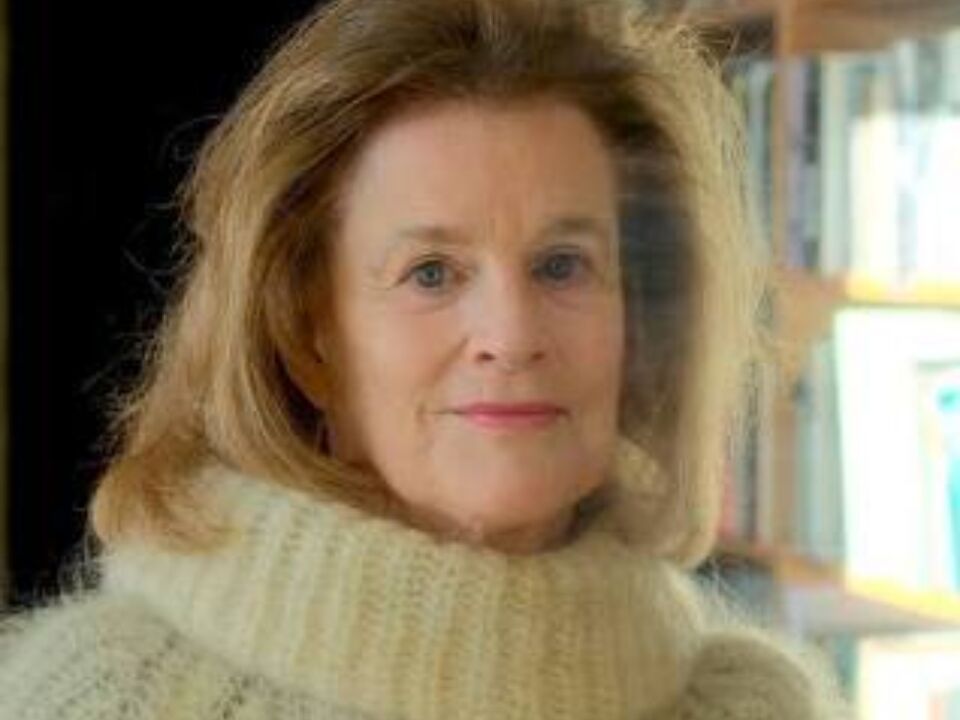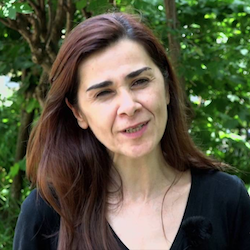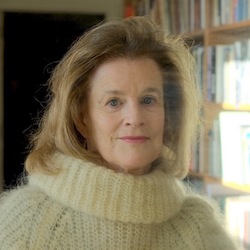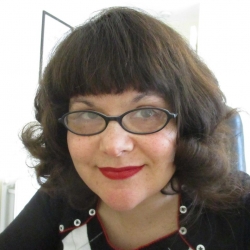
“To Find Our Place”: In Conversation with Négar Djavadi
Read Lisa Mullenneaux's interview with Négar Djavadi, translated by Tina Kover, in Issue 43: Fall 2018 of The Puritan. Then, check out our writing contest!
Négar Djavadi’s debut novel, Disoriental, is memorable for its high-spirited hero, Kimiâ, a queer punk-rock aficionado, storyteller extraordinaire, and, above all, a modern woman divided between family traditions and her own “disorientalization.” A bestseller in France, Disoriental has been awarded the Prix du Style, Prix Littéraire de la Porte Dorée, the RTBF Prix Première, and the Emmanuel Roblès First Novel Prize, among others. An English translation by Tina Kover of the novel was published by Europa Editions in 2018. As of this publication, it is shortlisted for the National Book Award for Translation.
In the novel, Kimiâ Sadr flees Iran at the age of 10 in the company of her mother and sisters to join her father in France. Now 25, sitting in a fertility clinic in Paris as she awaits life-changing news, Kimiâ relives her turbulent past and the stories of her ancestors that come to her in unstoppable waves. Generations of flamboyant Sadrs return to her, including her formidable great-grandfather, Montazemolmolk, with his harem of 52 wives and her parents, Darius and Sara, dedicated resistors of each regime that befalls them.
Négar Djavadi is a screenwriter and lives in Paris. She responded to Lisa Mullenneaux’s questions in French and her responses were translated by Mullenneaux and Europa publicist Rachael Small. Mullenneaux is a New York journalist and translator.
Lisa Mullenneaux: How much of Kimiâ Sadr’s story is your own story? Négar Djavadi: Like me, Kimiâ is born into a family of political opponents, first to the Shah’s regime, and then to that of Khomeini. A family of intellectuals, cultivated and educated; this is important in Iran’s very hierarchical society. Even though the character traits of Kimiâ's parents are not completely the same as my parents’, this political struggle is the backbone of our two families. Building on that is the part of the story most like what I experienced: the revolution of ‘79 and the escape from Iran over the mountains of Kurdistan. The Sadr’s apartment in Tehran, the theater of an intellectual revolution, is the one in which I grew up. Just as I crossed these mountains to Turkey with my family. In writing Disoriental I wanted to place myself inside a character whose personal history joined up with “History”: for me that history could only be 20th century Iran. LM: You begin telling her story—and that of her martyred father—by addressing French citizens. Then the “you” becomes a more general readership. To what extent do the French still think of Iran as “a fanatical backwater at war with the West”? ND: I think that in a general way the French think of Iran as a fanatical country at war with the West, though their point of view has begun to change since the signing of the nuclear agreements. Iran has almost become a tourist destination! In fact, many French people who have traveled to Iran with tour operators tell me that the country did not correspond to what they expected. Or rather, Iranians did not correspond to what they expected. Seeing the country for themselves allows them to reject any myths they have heard and understand that this dictatorial regime has been imposed on the people, like any dictatorship. And it is Iranians who suffer from it most. The fact that this is a theocratic "religious" regime tends to confuse the issue; it suggests that because the country is Muslim, people aspire to a totalitarian regime that applies sharia. This is all the more wrong because historically Iran was not a country, like Saudi Arabia, built around religion. At the same time, because the regime of the mullahs has been in power for 40 years, a whole generation of Europeans do not know another face of Iran except that of repression and fanaticism. They can’t even imagine the Iran of the ‘70s, which I describe in the book.
ENDNOTES [1] The overthrow of the democratically elected Prime Minister Mohammad Mosaddegh, engineered by the U.S. and Britain. Négar Djavadi
Négar Djavadi
 Lisa Mullenneaux
Lisa Mullenneaux
 Tina Kover
Tina Kover
Lisa Mullenneaux: How much of Kimiâ Sadr’s story is your own story? Négar Djavadi: Like me, Kimiâ is born into a family of political opponents, first to the Shah’s regime, and then to that of Khomeini. A family of intellectuals, cultivated and educated; this is important in Iran’s very hierarchical society. Even though the character traits of Kimiâ's parents are not completely the same as my parents’, this political struggle is the backbone of our two families. Building on that is the part of the story most like what I experienced: the revolution of ‘79 and the escape from Iran over the mountains of Kurdistan. The Sadr’s apartment in Tehran, the theater of an intellectual revolution, is the one in which I grew up. Just as I crossed these mountains to Turkey with my family. In writing Disoriental I wanted to place myself inside a character whose personal history joined up with “History”: for me that history could only be 20th century Iran. LM: You begin telling her story—and that of her martyred father—by addressing French citizens. Then the “you” becomes a more general readership. To what extent do the French still think of Iran as “a fanatical backwater at war with the West”? ND: I think that in a general way the French think of Iran as a fanatical country at war with the West, though their point of view has begun to change since the signing of the nuclear agreements. Iran has almost become a tourist destination! In fact, many French people who have traveled to Iran with tour operators tell me that the country did not correspond to what they expected. Or rather, Iranians did not correspond to what they expected. Seeing the country for themselves allows them to reject any myths they have heard and understand that this dictatorial regime has been imposed on the people, like any dictatorship. And it is Iranians who suffer from it most. The fact that this is a theocratic "religious" regime tends to confuse the issue; it suggests that because the country is Muslim, people aspire to a totalitarian regime that applies sharia. This is all the more wrong because historically Iran was not a country, like Saudi Arabia, built around religion. At the same time, because the regime of the mullahs has been in power for 40 years, a whole generation of Europeans do not know another face of Iran except that of repression and fanaticism. They can’t even imagine the Iran of the ‘70s, which I describe in the book.
Unlike Westerners who have “family secrets,” in the East, and in this case in Iran, we talk a lot, we tell everything, and we grow up in a family with all these characters from the past and these stories.LM: Sadr family history is such a rich tapestry, like a Persian rug. What sources did you use to create it besides your own memory? ND: Like most Easterners, I have a large family, with stories flowing in all directions. Unlike Westerners who have "family secrets," in the East, and in this case in Iran, we talk a lot, we tell everything, and we grow up in a family with all these characters from the past and these stories. So, I tried to transcribe this impression that I felt as a child living in the middle of a huge family—including ghosts!—but also the amazement of listening to stories told by the elders. I created some characters by drawing right and left from memory, others that I invented because they served the story, others that are a mix of people I knew. Finally, being imbued with this past helped me to compose a gallery of characters without my being overly concerned about whether the Western reader would recognize them. LM: Though Darius’ letter to the Shah in 1976 is later recognized as “the first stone of the Iranian Revolution,” his wife Sara is just as committed to fighting the Shah’s sham democracy. How does their partnership work? How does it affect their daughters? ND: The relationship between Sara and Darius is a very special relationship, based as much on the desire for freedom, justice, and democracy as on conjugal feelings—based on the certainty that it is up to them to do something, because they are educated in a country with an illiterate majority, because they are aware that oil money and the country’s riches do not serve the people. And this certainty goes back to their youth, even before they met, to the coup d'etat of 1953[1] which upset the country’s destiny. Thus, instead of being afraid, Sara supports Darius, encourages him to write this letter [denouncing the Shah], and even relieves him of the domestic aspects of life so that he will devote himself only to that. They have an apartment, children grow up, it's time now to turn to the country, to do something! Darius writes, Sara copy edits, cleans up the mistakes, discusses some points with him. Together, they end up creating a newspaper clandestinely. In fact, gradually family life takes second place, and it is their common fight that comes first. Their daughters are affected, of course, because they feel fear far more than their parents; their lives no longer resemble the lives of other children. But they, too, are in the heat of the moment—in the midst of a growing, expanding revolution—and aren’t old enough or able to reflect on the life their parents impose on them. That happens once the girls settle in France, and they begin to follow their individual destinies.
So, we keep silent, and we go forward as best we can, trying to get by ourselves, to find our place in this new world.LM: Your title, Disoriental, can mean both disoriented and non-Western, which is the reality the Sadrs confront after their escape to Paris. For exiles, you write, “survival is a very personal matter.” How so? ND: Exile means being propelled into an unfamiliar world, much like movie characters who suddenly find themselves in a world both familiar yet different, even strange. Faced with this new and unknown world, everyone is forced to fend for themselves. Because the way you look at yourself, what you need to do to continue living, or how you feel, depends on many factors: your age, your personality, your ability to accept this new society, your desire to detach from the lost world, your degree of pain, the people you left behind. A child must go to school, be confronted by class, but an adult doesn’t. An adult must find work, or go through administrative procedures, but her child doesn’t. A mother does not know how to help her child after school in a language she hasn’t mastered. One sister finds a friend, while another may be the victim of racist attitudes. In short, a feeling of loneliness embeds itself in everyone, a feeling difficult to share because even if we know that others do not experience exactly the same difficulties as we do, we know that it is also hard for them. Maybe even harder. So, we keep silent, and we go forward as best we can, trying to get by ourselves, to find our place in this new world. LM: Music changes Kimiâ’s life in many ways. How is it a passport out of the prison of traditional gender roles? ND: The "underground" music of the ‘80s, still driven by the punk movement, was not only music, but a way of being, of living, of understanding society, of opposing rules, conventions. This music allowed a whole lot of socially diverse people—rejected, ignored by society—to exist, to even go on stage, to express themselves. In this universe, nothing really mattered. We had the right to be who we were, to do what we wanted and we were accepted. It is this freedom that allows Kimiâ to escape her isolation and her questions about her sexuality. In music she finds a “country.” A place removed from Iran and France, past and future, removed from parents, their suffering, their inhibitions. Kimiâ isn’t so much in exile as she is wandering in search of herself and the world. Music bridges the gap between past and present, between childhood and adolescence. It accepts her “hybrid body.” LM: Your final scene between Kimiâ and Sara brings closure to many threads of this narrative. Not the least is mother’s and daughter’s mutual love of children. When did you decide that fertility would be a major theme? ND: In fact, the theme of motherhood, of childbearing, prevailed during writing. Having children is very important in the life of an Iranian woman. Not having a child is even considered a great misfortune, which could not possibly result from a woman’s personal choice, but is necessarily a tragedy. So it seems natural that Sara, with her three daughters, insists on the idea of having children, but if she differs from other Easterners, it is in the fact that she prefers girls to boys. On the other hand, motherhood as a theme emerged when I discovered that, by writing about the birth of grandmother Nour in a harem, I could tell the story of the evolution of the Iranian woman through her pregnancies and deliveries, from squatting over an earthen bowl to the hospital where Sara gives birth to her daughters. Between these two periods, women, like Sara, began to work, to become economically independent, to have fewer children, and to have political opinions. This historical shift corresponds to that of Iran, a country that was certainly conservative during the ‘70s, but evolving towards a true secularism and a certain modernity before the mullahs came to power. It spans, within a century, from the great grandmother, who dies anonymous after giving birth to her twin girls, to Kimiâ, waiting in a doctor’s office in Paris, a world that has changed for Iranian women and for the country.
ENDNOTES [1] The overthrow of the democratically elected Prime Minister Mohammad Mosaddegh, engineered by the U.S. and Britain.
 Négar Djavadi
Négar Djavadi
 Lisa Mullenneaux
Lisa Mullenneaux
 Tina Kover
Tina Kover


